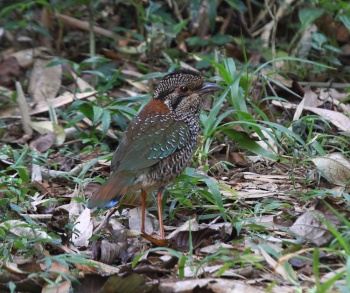- Geobiastes squamigera
Identification
25-32 cm, a large rainforest Ground Roller with long legs.
- Buffish white head and underparts with brown and black scaling
- Orange-pink fleshy eyering and prominent patch behind eye
- Prominent black bands on central crown, behind eye and across ear-coverts below eye
- Less scaly and more buffy belly and vent
- Rufous hindcollar
- Bronzy green wings with dark brown secondaries and primaries; buffish-white wingbar visible in flight
- White crescent-shaped markings outlined in turquoise or blue-grey and black on lower mantle, scapulars and wing-coverts
- Rufous tail with bronzy green base
Sexes similar, females slightly smaller. Juveniles are dull rufous over crown, nape, breast and flanks and dingy white on chin and centre of abdomen.
Distribution
Dense rainforests of central and north-eastern Madagascar.
An uncommon restricted-range species.
Taxonomy
This is a monotypic species[1].
It is sometimes placed in the genus Brachypteracias.
Habitat
Moist lowland forests. Prefers undisturbed dark areas with large trees and dense and tangled vegetation with damp soil. Also in relatively open understorey and recently observed in secondary growth.
Occurs from sea-level up to 950m.
Behaviour
Diet
Feeds on invertebrates, mainly on earthworms. Forages on the ground. Often waits silently for prey but also does short runs and foraging bouts, investigating logs and rummages through deep leaf litter with its bill. Perches up to 10 m high, sometimes flying short distances to catch butterflies or hawks flies in air.
Breeding
Breeding season from September to January. Probably a monogamous and territorial species. Nests are built in ground burrows and a single egg clutch is laid. Incubation, done only by the female, lasts 18 days and the young fledge at 24 days. Both parents feed the young.
Movements
A sedentary species with some movements related to change with weather and associated drying-out of the species’ feeding habitat.
References
- Clements, J. F., T. S. Schulenberg, M. J. Iliff, D. Roberson, T. A. Fredericks, B. L. Sullivan, and C. L. Wood. 2016. The eBird/Clements checklist of birds of the world: v2016, with updates to August 2016. Downloaded from http://www.birds.cornell.edu/clementschecklist/download/
- Handbook of the Birds of the World Alive (retrieved August 2016)
Recommended Citation
- BirdForum Opus contributors. (2024) Scaly Ground Roller. In: BirdForum, the forum for wild birds and birding. Retrieved 12 May 2024 from https://www.birdforum.net/opus/Scaly_Ground_Roller





